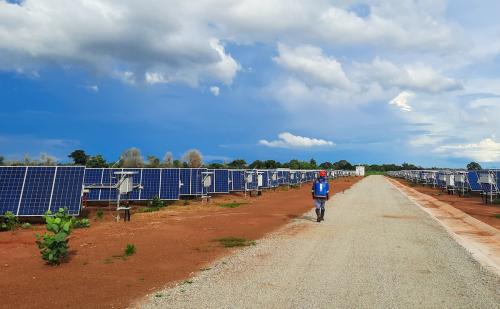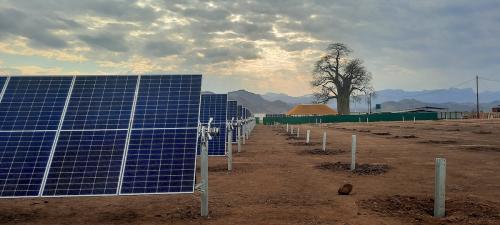This viewpoint is part of Foresight Africa 2024.
Rapid urbanization and climate change are impacting informal settlements in sub-Saharan Africa. An informal settlement or slum is generally defined as a highly populated urban area that has no infrastructure for human habitation and is densely packed with dwelling units constructed with weak materials of poor quality. Climate change affects slum communities disproportionately when compared to their formal counterparts. Informal settlements are formed organically by residents who occupy land not planned for residential living. Aside from having no infrastructure, the land is precarious and unwanted, often near industry structures or dumpsites along rivers. Hidden from sight are the impacts of climate change on food insecurity, malnutrition, and disease in these communities. Policy change is urgent: Residents of informal settlements make up over 60% of the urban population on the continent of Africa.1
Drought
Since late 2016, drought has plagued the African continent, particularly in East Africa, creating food insecurity and malnutrition. In March 2023, the World Health Organization reported 7,800 cholera cases in Kenya due to drought and 122 deaths. While our minds habitually go to areas in northern Kenya—like Turkana—or eastern Kenya—like Tana River, urban Nairobi was also affected. In Nairobi, the Kenyan Ministry of Health reported 11,181 cholera cases and 196 fatalities in July 2023. A targeted cholera campaign intended to vaccinate 300 Nairobi residents per day was surpassed, reaching 500 residents per day, according to the vaccine organization GAVI.2 Effective infrastructure can mitigate disease and health issues related to climate change in informal settlements.
Floods
In 2022, 600 people were killed in Nigeria’s worst flood in decades. In the same year, floods in West and Central Africa affected 8.2 million people in 20 countries—killing 1,418, injuring 4,398, and displacing 2.9 million people. While formally planned urban areas are zoned in locations safe for habitation, informal settlements are in precarious locations, often beside rivers, making residents more vulnerable to floods. For many slum residents, the river becomes a dumping ground for trash and waste. Each year, homes along Kenya’s Ngong River float away during rapid flooding due to climate-induced heavy rainfall, after which residents search for their belongings and missing relatives. Excess water lays dormant near homes and attracts mosquitos which may carry malaria or other blood-borne diseases like yellow fever, dengue fever, or West Nile.3 Stagnant water breeds more waterborne diseases than running water, including typhoid fever, cholera, giardia, dysentery, e-coli, hepatitis, and salmonella, all of which put residents of informal settlements near excess flood water at risk.
Excessive heat
The realities of increasing urbanization, rising average temperatures, and the population density in informal settlements gained attention during the COVID-19 pandemic.4 Living in high-density slums increases heat due to a lack of open space. Heat makes you sweat, causing you to lose the water you have in the body. These effects are heightened for residents of informal settlements who cannot afford the recommended fresh water intake. In high-density slums, dwellings are, on average, approximately 10ft x 12ft with one or no windows at all, occupied by up to six people, and built along narrow 2-3ft mud paths. Slum dwellings are typically constructed of cinder-block, mud, and sticks, or corrugated tin. Some of these materials hold heat, leading to increased human suffering as temperatures continue to increase in urban cities. A study from Johns Hopkins University on climate revealed that Nairobi’s slums range from 5 to 10 degrees Fahrenheit hotter than the central business district.5
With the 1.4 billion population boom expected by 2063, informal settlements and climate-based issues must be addressed, lest half the population of Africa be lost due to lack of foresight.
Policy recommendations
The reality that over 60% of Africa’s urban population live in informal settlements cannot be denied, nor can it be denied that a country’s population is its best asset. With the 1.4 billion population boom expected by 2063, informal settlements and climate-based issues must be addressed, lest half the population of Africa be lost due to lack of foresight.6 In light of these facts, my recommendations are: 1. Settle land tenure issues in slums. A working model is community tenancy. 2. Change the development approach: Ditch the high-rise model and upgrade slums with water and sanitation, keeping climate-smart ecology at the forefront of design. 3. Enact eco-measures to prevent rivers from overflowing and to capture excessive water to offset droughts. 4. Empower paid community health workers to manage 50 homes each in informal settlements for basic health issues, and to accurately report data linked to climate change. 5. Use micro-carbon credits to incentivize community-led kitchens that use clean gas to deter the use of wood and charcoal for cooking in slums. Addressing the challenges in informal settlements is key to fostering climate-resilient urban cities. The last mile of urbanization can be reached with climate at the forefront of “Leapfrogging to Settle the Informal Settlement,” that blends African Village Culture with climate-smart urban living as a blueprint for reclaiming the health and resilience of 60% of the continental population.
-
Footnotes
- Amegah, A. Kofi. “Slum decay in Sub-Saharan Africa: Context, environmental pollution challenges, and impact on dweller’s health.” Environmental Epidemiology 5.3 (2021).
- Joyce Chimbi. 2023. “Averting a cholera disaster in Nairobi’s informal settlements.” Gavi. https://www.gavi.org/vaccineswork/averting-cholera-disaster-nairobis-informal-settlements#:~:text=%22The%20number%20of%20people%20 vaccinated,City%20County%20department%20of%20health.
- Nabatanzi, Maureen, et al. 2022. “Malaria outbreak facilitated by increased mosquito breeding sites near houses and cessation of indoor residual spraying, Kole district, Uganda, January-June 2019.” BMC Public Health 22.1: 1898.
- Mehrolhassani, Mohammad Hossein, et al. 2022. “Health protection challenges of slums residents during the COVID-19 pandemic, according to the social determinants of health framework: A case study of Kerman city in Iran.” Journal of Education and Health Promotion 11.
- Scott, Anna A., et al. 2017. “Temperature and heat in informal settlements in Nairobi.” PloS one 12.11: e0187300.
- Weny, K., R. Snow, and S. Zhang. 2017. “The demographic dividend atlas for Africa: Tracking the potential for a demographic dividend.” UNFPA.
The Brookings Institution is committed to quality, independence, and impact.
We are supported by a diverse array of funders. In line with our values and policies, each Brookings publication represents the sole views of its author(s).








Commentary
Informal settlements and climate change in the ‘last mile of urbanization’
February 29, 2024